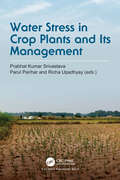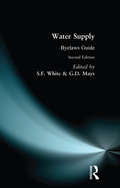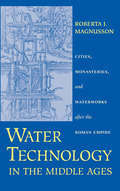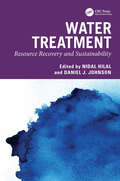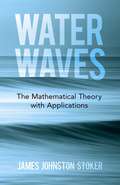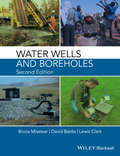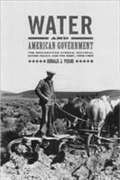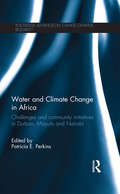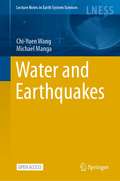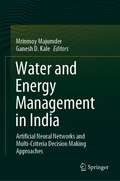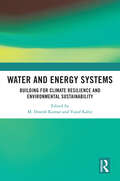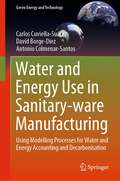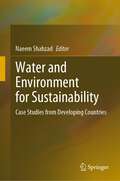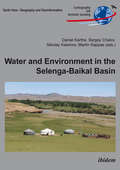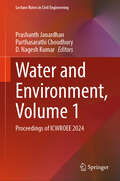- Table View
- List View
Water Stress in Crop Plants and Its Management
by Parul Parihar Prabhat Kumar Srivastava Richa UpadhyayThe book provides an overview of water stress in plants and alterations in the physiology, morphology, anatomy, and molecular mechanism due to water stress. The induction of water stress hormones and the up-regulating genes synthesizing them is also the major thrust of the book. It also deals with the water and nutrient uptake, alteration in water relations, transpiration and stomatal conductance, and hence in the amount of photosynthesis vis-à-vis water stress. It compiles recent studies on redox regulation, antioxidative systems, nitrogen metabolism and phytohormonal regulation in crop plants during water stress. Different strategies to manage water stress, viz. by using different osmolytes, proteins, hormones and growth regulators, antioxidants, plant extracts, nitric oxide donors, macro and micro mineral nutrients, and the use of silicon have been discussed. The viability of different biotechnological tools to make crop plants less water-demanding, the use of vetiver grass and the insertion of mycorrhiza in water-stressed crop plants have been explored. An exhaustive review of recent literature encompassing genomic, proteomic, transcriptomic, ionomics, and metabolomics approaches to have a better understanding of water stress is the prominent feature of the present book. It discusses major signaling molecules involved in water-stressed environments as well as the crosstalk with other minerals, phytohormones etc. Not least, the book endeavors to illustrate different water conservation methods to achieve sustainable agriculture. The book is a comprehensive compilation of work to date on water stress and its management techniques and this will bridge the missing gap between the research from the past to the current time.
Water Stress: A Case Study of Ta'iz, Yemen (King's SOAS Studies in Development Geography)
by Chris D. HandleyWhy is the bread basket of Arabia importing more water via grain than is pumped locally by all sectors and why does nobody notice? How can the same water be sold to different users at prices varying by five orders of magnitude? How can the biggest names in development throw millions of dollars at supplying water to a city and not an extra drop has emerged? Why do some of the wealthiest companies in the Middle East and their multinational associates get away with polluting water resources? This book presents the complex and fascinating account of Ta'iz, Yemen, a city embroiled in severe water stress as a consequence of environmental degradation, political facades, conflicting legal systems, military intervention and institutional incompetence. The result is a remarkable, compelling and controversial book which will be essential reading for academics, development agencies and NGOs around the world.
Water Supply Byelaws Guide
by S. F. White G. D. MaysFirst published in 1990. Routledge is an imprint of Taylor & Francis, an informa company.
Water Sustainability (Encyclopedia of Sustainability Science and Technology Series)
by Harry X. ZhangThis newly updated Water Sustainability volume of the Encyclopedia of Sustainability Science and Technology (ESST) takes a holistic view of full water cycle and integrates the water themes into sustainability science and technology.With the increasing pressures of population growth, water scarcity, flooding, water pollution, climate impacts and competition of water uses among municipal, agricultural, industrial sectors and ecosystem, there is a growing trend in promoting Integrated Water Management and “One Water” concept worldwide. This reference volume covers multi-disciplinary sustainability topics from the perspective of integrated water management, which includes drinking water, wastewater, stormwater, reclaimed water and groundwater. It also spans cross-cutting themes of the water-energy-food nexus, showing how all of these sectors are inextricably linked.Water Sustainability is a comprehensive resource for a broad audience of scientists and engineers, researchers and practitioners, and decision makers whose objective is to advance sustainable water management.
Water Sustainability: A Global Perspective
by J.A.A. JonesUsing the latest mapping techniques, J.A.A. Jones, Chair of the IGU Commission for Water Sustainability, examines water availability, the impact of climate change and the problems created for water management worldwide as well as possible solutions.Water Sustainability: A Global Perspective is one of the first textbook to meld the physical and human aspects affecting the world's water resources. Part One outlines the challenges and investigates the human factors: population growth; urbanization and pollution; the commercialization of water, including globalization and privatization; and the impacts of war, terrorism and the credit crunch. Part Two examines the physical aspects: the restless water cycle, the impact of past and future climate change and the problems change and unreliability create for water management. Part Three discusses current and future solutions including improved efficiency and water treatment systems, desalination, weather modification and rainwater harvesting, and improved legal and administrative frameworks. Jones concludes by asking how far technical and financial innovations can overcome the limitations of climatic resources and examining the human and environmental costs involved in such developments.This book is the ideal text for any student of water sustainability whether approaching the subject from the point of view of international relations, geography or environmental management.
Water Systems Analysis, Design, and Planning: Urban Infrastructure
by Mohammad KaramouzThis book presents three distinct pillars for analysis, design, and planning: urban water cycle and variability as the state of water being; landscape architecture as the medium for built-by-design; and total systems as the planning approach. The increasing demand for water and urban and industrial expansions have caused myriad environmental, social, economic, and political predicaments. More frequent and severe floods and droughts have changed the resiliency and ability of water infrastructure systems to operate and provide services to the public. These concerns and issues have also changed the way we plan and manage our water resources. Focusing on urban challenges and contexts, the book provides foundational information regarding water science and engineering while also examining topics relating to urban stormwater, water supply, and wastewater infrastructures. It also addresses critical emerging issues such as simulation and economic modeling, flood resiliency, environmental visualization, satellite data applications, and digital data model (DEM) advancements. Features: Explores various theoretical, practical, and real-world applications of system analysis, design, and planning of urban water infrastructures Discusses hydrology, hydraulics, and basic laws of water flow movement through natural and constructed environments Describes a wide range of novel topics ranging from water assets, water economics, systems analysis, risk, reliability, and disaster management Examines the details of hydrologic and hydrodynamic modeling and simulation of conceptual and data-driven models Delineates flood resiliency, environmental visualization, pattern recognition, and machine learning attributes Explores a compilation of tools and emerging techniques that elevate the reader to a higher plateau in water and environmental systems management Water Systems Analysis, Design, and Planning: Urban Infrastructure serves as a useful resource for advanced undergraduate and graduate students taking courses in the areas of water resources and systems analysis, as well as practicing engineers and landscape professionals.
Water Technology in the Middle Ages: Cities, Monasteries, and Waterworks after the Roman Empire (Johns Hopkins Studies in the History of Technology)
by Roberta J. MagnussonFocusing attention on gravity-fed water-flow systems in medieval cities and monasteries, Water Technology in the Middle Ages: Cities, Monasteries, and Waterworks after the Roman Empire challenges the view that hydraulic engineering died with the Romans and remained moribund until the Renaissance. Roberta Magnusson explores the systems' technologies—how they worked, what uses the water served—and also the social rifts that created struggles over access to this basic necessity.Mindful of theoretical questions about what hastens technological change and how society and technology mutually influence one another, the author supplies a thoughtful and instructive study. Archeological, historical, and literary evidence vividly depicts those who designed, constructed, and used medieval water systems and demonstrates a shift from a public-administrative to a private-innovative framework—one that argues for the importance of local initiatives. "The following chapters attempt to chart a course between the Scylla and Charybdis of technological and social determinism. While writing them, I have tried to strike a balance between the technical and human aspects of medieval hydraulic systems, and to remember that beneath the welter of documents and diffusion patterns, configurations and components, ordinances and expenditures, lie the perceptions, the choices, and often the plain hard work of individual men and women." —from the Preface
Water Trading and Global Water Scarcity: International Experiences (RFF Press Water Policy Series)
by Josefina MaestuWater scarcity is an increasing problem in many parts of the world, yet conventional supply-side economics and management are insufficient to deal with it. In this book the role of water trading as an instrument of integrated water resources management is explored in depth. It is also shown to be an instrument for conflict resolution, where it may be necessary to reallocate water in the context of increasing scarcity. Recent experiences of implementation in different river basins have shown their potential as instruments for improving allocation. These experiences, however, also show that there are implementation challenges and some limitations to trading that need to be considered. This book explores the various types of water trading formulas through the experience of using them in different parts of the world. The final result is varied because, in most cases, trading is conditioned by the legal and institutional framework in which the transactions are carried out. The role of government and the definition of water rights and licenses are critical for the success of water trading. The book studies the institutional framework and how transactions have been undertaken, drawing some lessons on how trading can improve. It also analyses whether trading has really been a positive instrument to manage scarcity and improve water ecosystems and pollution emission problems in those parts of the world which are most affected. The book concludes by making policy proposals to improve the implementation of water trading.
Water Treatment Plant Operation, Volume 1
by Office of Water Programs at Sacramento StateWater Treatment Plan Operation Textbook, Volume 1, Edition 7 - Water Programs at Sacremento State
Water Treatment in Urban Environments: Examples from South/Southeast Asia (Applied Environmental Science and Engineering for a Sustainable Future)
by Veeriah Jegatheesan Nevelina Pachova Perlie VelascoThe value of implementing nature-based solutions (NbS) for water treatment in urban environments is increasingly recognized due to the multiple ecosystem services and societal benefits they provide. The successful implementation of NbS for urban water treatment, however, depends on a range of diverse technical and societal factors that need to be taken into account. Those vary by the type of NbS implemented, the societal challenges the NbS are designed to address and the local ecological, socio-economic and political context, in which the solutions are implemented. This book provides a collection of guidelines for the implementation of three types of NbS for water treatment in urban environments across cities in South/Southeast Asia, namely constructed wetlands, green roofs and floating treatment wetlands. The guides were developed based on existing experiences with the establishment, operation, and maintenance of those three types of NbS in three different countriesin South/Southeast Asia and the lessons learnt from their implementation. They provide detailed outlines of suggested steps for ensuring successful implementation in the respective local contexts. Those include overall planning schemes, surveys for socio-economic evaluations, suggested methods for construction and associated costs, required maintenance as well as a range of operational monitoring parameters. It also includes examples of approaches for the scaling of the three types of NbS discussed in the book in their respective local contexts. This book is expected to benefit local government units and contractors, and other stakeholders involved in NbS implementation and up-scaling, as well as researchers and postgraduate students who plan to conduct pilot-scale studies on NbS.
Water Treatment: Resource Recovery and Sustainability
by Nidal Hilal and Daniel J. JohnsonWater Treatment: Resource Recovery and Sustainability provides a comprehensive overview of the latest research in increasing the sustainability of water treatment processes. The use of nontraditional water sources, such as desalination of seawater and reuse of treated wastewater, is increasingly important given the paucity of freshwater resources globally. Only a very small fraction of the Earth’s water is fresh surface water easily available for use, while 40% of the global population are classed as living in high water stress areas. As such, increasing effort is being made to tap into nontraditional water sources, such as desalination of seawater and reuse of treated wastewater, to make up this shortfall.This book presents the latest research in methods for limiting the environmental and economic costs of the processes involved in using nontraditional sources of water. To increase the efficiency of treatment processes, research has focused on recovery of resources from their associated waste streams; generation of: heat, pressure, and electricity from salinity gradients; recovery of nutrients such as nitrogen and phosphates; recovery of valuable minerals such as metals concentrated in desalination brine; and optimization of water reuse from wastewater. This comprehensive book is aimed at graduate students, researchers, and academics working or teaching in this subject area and will be of interest to water industry professionals.
Water Wars
by Vandana ShivaAcclaimed author and award-winning scientist and activist Vandana Shiva lucidly details the severity of the global water shortage, calling the water crisis "the most pervasive, most severe, and most invisible dimension of the ecological devastation of the earth." She sheds light on the activists who are fighting corporate maneuvers to convert the life-sustaining resource of water into more gold for the elites and uses her knowledge of science and society to outline the emergence of corporate culture and the historical erosion of communal water rights. Using the international water trade and industrial activities such as damming, mining, and aquafarming as her lens, Shiva exposes the destruction of the earth and the disenfranchisement of the world's poor as they are stripped of rights to a precious common good. Revealing how many of the most important conflicts of our time, most often camouflaged as ethnic wars or religious wars, are in fact conflicts over scarce but vital natural resources, she calls for a movement to preserve water access for all and offers a blueprint for global resistance based on examples of successful campaigns. Featuring a new introduction by the author, this edition of Water Wars celebrates the spiritual and traditional role water has played in communities throughout history and warns that water privatization threatens cultures and livelihoods worldwide.
Water Waves: The Mathematical Theory With Applications (Dover Books on Physics)
by James Johnston StokerFirst published in 1957, this is a classic monograph in the area of applied mathematics. It offers a connected account of the mathematical theory of wave motion in a liquid with a free surface and subjected to gravitational and other forces, together with applications to a wide variety of concrete physical problems. A never-surpassed text, it remains of permanent value to a wide range of scientists and engineers concerned with problems in fluid mechanics.The four-part treatment begins with a presentation of the derivation of the basic hydrodynamic theory for non-viscous incompressible fluids and a description of the two principal approximate theories that form the basis for the rest of the book. The second section centers on the approximate theory that results from small-amplitude wave motions. A consideration of problems involving waves in shallow water follows, and the text concludes with a selection of problems solved in terms of the exact theory. Despite the diversity of its topics, this text offers a unified, readable, and largely self-contained treatment.
Water Wells and Boreholes
by David Banks Lewis Clark Bruce MisstearWater Wells and Boreholes focuses on wells that are used for drinking, industry, agriculture or other supply purposes. Other types of wells and boreholes are also covered, including boreholes for monitoring groundwater level and groundwater quality. This fully revised second edition updates and expands the content of the original book whilst maintaining its practical emphasis. The book follows a life-cycle approach to water wells, from identifying a suitable well site through to successful implementation, operation and maintenance of the well, to its eventual decommissioning. Completely revised and updated throughout, Water Wells and Boreholes, Second edition, is the ideal reference for final-year undergraduate students in geology and civil engineering; graduate students in hydrogeology, civil engineering and environmental sciences; research students who use well data in their research; professionals in hydrogeology, water engineering, environmental engineering and geotechnical engineering; and aid workers and others involved in well projects.
Water and American Government: The Reclamation Bureau, National Water Policy, and the West, 1902–1935
by Donald J. PisaniDonald Pisani's history of perhaps the boldest economic and social program ever undertaken in the United States--to reclaim and cultivate vast areas of previously unusable land across the country--shows in fascinating detail how ambitious government programs fall prey to the power of local interest groups and the federal system of governance itself.
Water and Climate Change in Africa: Challenges and Community Initiatives in Durban, Maputo and Nairobi (Routledge Advances in Climate Change Research)
by Patricia E. PerkinsIn the coming decades, countries around the world will face increasingly severe challenges related to global climate change. While the details vary from country to country, the impacts will be especially grave for marginalized people, whose access to food, potable water, and safe shelter may be threatened due to fluctuations in rainfall and temperature, and to extreme weather events. Because weather extremes are the main way that climate change manifests itself, water governance is a crucial aspect of climate change resilience. Following an overview of the ways climate change is affecting three cities in Africa, Water and Climate Change in Africa: Challenges and Community Initiatives in Durban, Maputo and Nairobi discusses the equity and climate justice implications, and then gives examples of ways in which a range of local community organizations are extending their current activities to address these challenges through innovative new programs and initiatives at the grassroots. This approach has implications for communities worldwide; it is a process of building on existing organizations’ aptitudes and strengths in the light of local knowledge of climate challenges, and creating partnerships to build equity-enhancing new methods of protecting people’s subsistence. This book should be of interest to climate change scholars, activists and policy-makers, as well as development studies researchers and practitioners.
Water and Development
by The World BankDevelopment patterns, increasing population pressure, and the demand for better livelihoods in many parts of the globe all contribute to a steadily deepening global water crisis. Development redirects, consumes, and pollutes water. It also causes changes in the state of natural water reservoirs, directly by draining aquifers and indirectly by melting glaciers and the polar ice caps. Maintaining a sustainable relationship between water and development requires that current needs be balanced against the needs of future generations. The development community has transformed and broadened its approach to water since the 1980s. As stresses on the quality and availability of water have increased, donors have begun to move toward more comprehensive approaches that seek to integrate water into development in other sectors. This evaluation examines the full scope of the World Bank's lending and grant support for water activities. More than 30 background papers prepared for the evaluation have analyzed Bank lending by thematic area and by activity type. IDA and IBRD (the Bank) have supported countries in many water-related sectors. The evaluation, by definition, is retrospective, but it identifies changes that will be necessary going forward, including those related to strengthening institutions and increasing financial sustainability. Lessons and results from nearly 2,000 loans and credits, and work with 142 countries are identified.
Water and Earthquakes (Lecture Notes in Earth System Sciences)
by Michael Manga Chi-Yuen WangThis open access book explores the interactions between water and earthquakes, including recent concerns about induced seismicity. It further highlights that a better understanding of the response of the water system to disturbances such as earthquakes is needed to safeguard water resources, to shield underground waste repositories, and to mitigate groundwater contamination. Although the effects of earthquakes on streams and groundwater have been reported for thousands of years, this field has only blossomed into an active area of research in the last twenty years after quantitative and continuous documentation of field data became available. This volume gathers the important advances that have been made in the field over the past decade, which to date have been scattered in the form of research articles in various scientific journals.
Water and Energy Management in India: Artificial Neural Networks and Multi-Criteria Decision Making Approaches
by Mrinmoy Majumder Ganesh D. KaleThis book provides an innovative, realistic and reliable solution to the common problem of Indian water and energy sector due to the onset of the Impact of Climate Change and Large-Scale Urbanization. Twelve Case Studies and One Review Paper that were included in this book depict the way soft computation techniques, simulation and decision-making framework can optimize the best solution from multiple solutions to the problems of water and energy management which corresponds to a novel symbiotic and synchronous nexus between water and the energy sector. All the studies included in this book are collected from all parts of India. The selected studies utilized the latest technologies like Multi-Criteria Decision Frame Work, Neural Networks and Nature-Based Optimization techniques to achieve diverse objectives from the prediction of climatic parameters to yield from ungauged watershed to performance optimization of Water Treatment Plant, Hydropower as well as futuristic alternative energy systems like Wave to Power Plants.
Water and Energy Systems: Building for Climate Resilience and Environmental Sustainability
by M. Dinesh Kumar and Yusuf KabirThis book addresses how water supply systems can be planned, designed, and managed for sustainability by presenting unique approaches and methodologies in rural drinking water supply schemes. It synthesizes the outcomes and findings of research studies undertaken by the Institute for Resource Analysis and Policy (IRAP) and pilot projects undertaken by RCUES (Regional Centre for Urban Environmental Studies) of AIILSG, Mumbai in collaboration with government of Maharashtra, with technical support from other development partners on climate-resilient water and energy systems.Backed by empirical research, this volume aims to build the conceptual foundations of the subject, additionally bringing in results of pilot projects that apply some of the models in water conservation, clean energy production, and environmental management. Towards building a climate-resilient society, it also discusses the feasibility of reducing carbon emissions in rural water supply, to make it more energy efficient.The book will be useful to students, researchers, and teachers working on Water Resources, Water Supply, Renewable Energy systems, Management of Climate-Induced Disasters, Water-Energy-Climate Policy, and Development Studies. This will also be an invaluable companion to policy makers, general administrators, civil society organizations, media persons, and bilateral agencies like WHO, UNICEF, UNDP, UNEP, World Bank, and the Gates Foundation.
Water and Energy Use in Sanitary-ware Manufacturing: Using Modelling Processes for Water and Energy Accounting and Decarbonisation (Green Energy and Technology)
by Antonio Colmenar-Santos Carlos Cuviella-Suárez David Borge-DiezThis book analyses and quantifies how and where energy and water are consumed by the ceramic sanitary-ware industry and provides solutions as to how to reduce this. The whole production process is mapped, including modelling methods.The book begins by providing an introduction to ceramic sanitary-ware production and types of factories casting technology. It then moves on to discuss the process and energy modelling for the production line, analysis of energy and water consumptions and proposals for improvements. The last chapter presents the practical implementation of the selected modelling configuration. This book is of particular interest to water and energy management professionals within the ceramic industry, but the methods are of interest to those in other production industries as well.
Water and Environment for Sustainability: Case Studies from Developing Countries
by Naeem ShahzadThe International Conference on Water, Energy, and Environment for Sustainability (IC-WEES) 2022 is a flagship conference of National University of Sciences and Technology (NUST), Pakistan. With the growing global concerns about environmental degradation, depletion of freshwater resources, and climate change-induced disasters, this year the IC-WEES is focused on climate change, water, environment, and disaster risk reduction (DRR) and their interrelationship with each other. Given the continuous evolution of contemporary scientific research work, it is progressively encouraging that there must be strong collaboration between experts, researchers, and research sharing platforms. Believing in this, the IC-WEES 2022 aims to bring expert individuals and diverse research groups to exchange and share R&D updates and discuss sustainable solutions to challenges in climate change, DRR, environment and water resources management, and respective nexuses between these fields. The conference proceedings consists of multi-disciplinary topics on the themes. As with every passing day, the climate change impacts are becoming visible, there is a dire need to understand the complex inter-relationships of climate changes, environment, water, and energy nexuses in order to lead to more sustainable solutions for our future generations. Our region is presently suffering from unprecedented heat waves, and prospective readers will be quite curious to know about the latest researches being carried out in this region with regard to environment, climate change, and water in order to reduce the disaster risks the continent is likely to face in near future.
Water and Environment in the Selenga-Baikal Basin: International Research Cooperation for an Ecoregion of Global Relevance (Earth View - Geography and Geoinformation #23)
by Daniel Karthe Sergey Chalov Nikolay Kasimov Martin KappasThe water resources of the Selenga River/Lake Baikal system are essential to the ecosystems and economic development of the surrounding region. In this large river and lake basin, there are strong contrasts between relatively pristine areas and massive anthropogenic impacts on the environment. The effects of climate change are more pronounced than in most other parts of the earth, and the transition from socialism into a market-oriented economy has led to a boom in mining but also to a partial collapse of environmental monitoring and urban wastewater management systems. Moreover, the expansion of agriculture and mining has triggered considerable land use change, rising water consumption, and the release of contaminants that had previously been unknown to the region. The consequences for the water resources and the aquatic and terrestrial ecosystems depending on them have become increasingly visible in recent years. This book, which is based on contributions to the 2014 Bringing Together Selenga-Baikal Research Conference, provides multidisciplinary insight into current water-related challenges and strategies for their solution from the viewpoint of the international scientific community.
Water and Environment, Volume 1: Proceedings of ICWROEE 2024 (Lecture Notes in Civil Engineering #413)
by D. Nagesh Kumar Prashanth Janardhan Parthasarathi ChoudhuryThis book presents select proceedings of the International Conference on Water Resources, Ocean, and Environmental Engineering (ICWROEE 2024). It strives to promote an interdisciplinary approach to water management by taking various environmental factors into consideration. This book covers theoretical principles with real-world applications and equips readers with the knowledge and tools necessary to address the pressing challenges of water resources engineering in an era of increasing water scarcity and climate change. The book serves as an invaluable reference for researchers and professionals in the fields of water resources management, environmental engineering, and ocean engineering. It also inspires the next generation of water resource engineers to create sustainable solutions for the management and preservation of our most precious natural resource—water.
Water and Environment, Volume 2: Proceedings of ICWROEE 2024 (Lecture Notes in Civil Engineering #414)
by D. Nagesh Kumar Prashanth Janardhan Parthasarathi ChoudhuryThis book presents select proceedings of the International Conference on Water Resources, Ocean, and Environmental Engineering (ICWROEE 2024). It strives to promote an interdisciplinary approach to water management by taking various environmental factors into consideration. This book covers theoretical principles with real-world applications and equips readers with the knowledge and tools necessary to address the pressing challenges of water resources engineering in an era of increasing water scarcity and climate change. The book serves as an invaluable reference for researchers and professionals in the fields of water resources management, environmental engineering, and ocean engineering. It also inspires the next generation of water resource engineers to create sustainable solutions for the management and preservation of our most precious natural resource—water.
